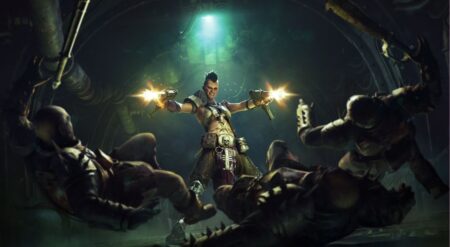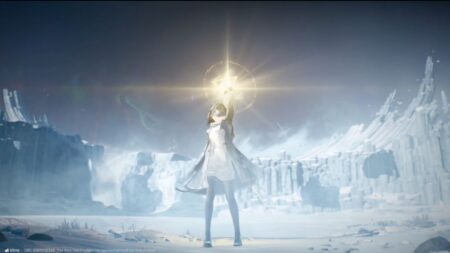
Magic Legends is an isometric top-down action RPG developed by Cryptic Studios and published by Perfect World Games. The spark; the magical property that allows a planeswalker to cross through the Blind Eternities to the various realms of the Multiverse. It is what makes planeswalkers unique. Now, your spark has ignited. It is time for your journey to begin in the Magic Legends Beta.
Having first come into contact with the many worlds of Magic: The Gathering way back around 2000, I have a long history with the property. From playing the original card game to reading various supplemental lore books, and even at one point earning my level one judge’s certification, my experiences with Wizards of the Coast’s iconic fantasy setting are long and mostly enjoyable. For this reason, since I first got my hands on the demo at PAX East 2020, I have been counting down the days till the Magic Legends Beta went live. Now that I have the game running on my laptop, I can say that I am truly enjoying my time in the various locales as I sling spells, summon minions, and interact with the various characters I have been battling with on the tabletop for the last two decades.
As players boot up Magic Legends, the first choice they will make is what class to play as. This choice will determine what the player’s basic abilities will be throughout the game, and what their starting deck construction will look like as players will initially build their deck of cards exclusively in their starting color. From the supportive Sanctifier who specializes in keeping their allies and summoned creatures strong and healthy, to the fiery Geomancer who wields the power of the earth to both crush foes and absorbs deadly blows, each of the five starting choices offers their unique gameplay styles.
For me, I choose the Sanctifier. As someone who isn’t generally interested in grouping up with random strangers, and wanting to be able to tackle dungeons at my own pace, I wanted to make sure I would have plenty of means to keep me and my summoned minions on our feet. And while the class certainly delivers in that regard, the Sanctifier also happily delivers more than just being a glorified medic. And no matter which class you start with, the options to build out your character grow exponentially as you play the game. Though it does take a little time to get there.
As with most RPG games, the opening of the Magic Legends Beta is fairly slow. The player initially starts with a single spell slot open in their hand and a few spells to work with. As is always the case, this is to keep new players from feeling overwhelmed by information and options. Over the first couple hours of gameplay the player steadily unlocks new cards, as well as slots in their hand until they reach the full count of twelve spells in their deck and four cards available in their hand to cast.
The slowness in this first handful of hours is even more heightened because most of the other elements of character progression are held to a minimum during this time. Equipment and artifacts are virtually unseen during these early moments, making the initial impressions for the Magic Legends Beta to be a bit boring. However, if you get past these few hours, the game opens up nicely.
The bulk of your time will be spent running around one of the game’s open worlds. With five initial areas to planeswalk to, players have a variety of locales to check out. From the sandy, lava-filled land of Shiv to the floating islands of Zendikar and the gothic horrors of Innistrad, each plane delivers its own look and feel.
I love the game visuals. The regions the player travels through are varied and distinct, the visual effects for magic attacks are always striking, and each creature and summon has its own combat animations. The only real struggle is just how many of these impressive effects and creatures can start clustering the screen. More than once I have been hit by an area of effect attack due to an inability to see exactly where I am. It doesn’t happen all the time, and usually when the enemy is swarming the creatures are easy enough to kill that the congestion doesn’t stick around for long. Effectively, it is the price for having the ability to have so much variety of spells and summon at your command. And honestly, I’m happy to pay for it.
While there is a larger story tying the player’s journey through these various fantasy locations together, each region is home to its own struggles and problems the player will become embroiled in. While the storytelling in the Magic Legends Beta isn’t anything groundbreaking, it is perfectly passable. If you didn’t mind the level of the story in other genre staples like Diablo 3, I don’t think I’ve seen anything that is going to break you here.
Another important note about the story is that no prior familiarity with the property is necessary. Despite the setting’s rich, multi-decade back story, the elements and plot points are kept clear and introduced and explained as needed.
As the player crosses the large open-world areas there are a variety of different styles of missions they can opt into on their way to whichever dungeon or point of interest they are headed for.
Skirmishes are quick events that range from stopping waves of enemies to freeing prisoners. While all the ones I’ve encountered boil down to fighting lots of enemies, the circumstances, types, and reasons for doing so vary enough to keep them from becoming mindless grinds.
The other most common event I’ve run into is Reliquaries. These small mini-dungeons are hidden away in dimensional rifts the player can hunt down. Once inside, the player will take on a boss for various loot. The floating ruin look of these mini excursions is striking and cool. And much of the equipment I’ve gotten in my time with the Magic Legends Beta has been acquired here.
But while the open world’s side events are fun, it is the full-size dungeons that hold the most danger, adventure, and rewards. As each dungeon is tied to the game’s plot, there is an increased sense of importance as well as scale to these longer strung-together chains of encounters.
When a player first approaches a dungeon, they are given a couple of choices to fine-tune their experience: whether they wish to tackle the dungeon solo or with a group as well as difficulty. The game also lets the player know what colors will work best in the dungeon. So if they have reached the point where they possess spells of various colors, they can fine-tune their deck should they wish to optimize their chances.
The actual moment-to-moment combat is, at its core, the classic point and click cooldown-driven mechanics the genre is known for. With a basic attack, plus secondary and utility attacks that are based on the character’s class, these function in all too familiar styles. It is in the playing of spells and how their availability rotates that makes Magic Legend’s combat stand out a bit from its contemporaries.
Players have a hand of four spells available to them at any given time. These spells are all fueled by a resource called mana. The player constantly generates mana until their gauge is filled. When the player has enough mana, they may cast a spell from their hand. After the spell is cast, the spell returns to its deck and a new one takes its place. The trick here is building a deck that balances focusing on the player’s main theme with having a wide enough range of spells to allow the player to overcome the various threats that the Magic Legends Beta will challenge them with. And part of obtaining this versatility comes with mixing spells of different mana colors.
Just as each class of planeswalker has a different specialty, so too do the spells that are associated with that class’s color. And while you only start with spells of your color, you will soon start discovering spells of other colors. This is where mana management and deck building become interesting.
While every spell in Magic Legends has a mana cost, they can’t all be played with just any mana. Generally, spells will require some or all of their cost to be paid in their mana color. So, for example, an angel summon spell might cost a total of five mana, but two of that mana must be white. When a player has a two-color deck, decks can not have more than two colors, the mana gauge fills with each color of mana in proportion to the number of cards of that color in the deck. So if a player has eleven cards that are white, and only one red card, the mana for white will fill much faster, and the total mana will always be vastly more white than red. This makes putting just one really powerful card outside of your primary color a little more difficult, as you might have a harder time casting it.
And while I find the nuance to balancing my deck’s colors interesting, it isn’t too stringent or unforgiving. As long as a player keeps some sense to how they approach decks, keeping things like cost, color, and attack spell vs. summon spells in a decent balance, they should be fine.
The final major gameplay element players will interact with when they log into the Magic Legends Beta is the progression/loot system. I’m putting these together because, as many will know, much of a player’s progress is tied as closely to their loot in games of this genre as they are to level. Magic Legends is no exception. And much like its card-based combat, the developers at Cryptic have taken a different approach with how they dispense loot and levels. And honestly, I like it.
Along with new spells for the player’s deck, spell fragments that can be used to increase the quality of spells, and gear and artifacts can be gained through the various battles. These, coupled with the constant stream of experience to level up the player’s character, make for a myriad of paths to improvement.
The big thing that sets the acquisition of gear, spells, and levels apart from many other games is the apparent choice to go for quality over quantity. I have yet to see a boss explode into a shower of loot like the bosses in so many other games in this genre. But, I’ve also never gotten a piece of loot that was total garbage either. Here, the game doesn’t waste my time with the equipment I would never want. It might not be good for my build at the moment but always has had merit.
Likewise, it never dispenses spell fragments for spells I don’t currently possess. And while the acquisition of gear, spells, artifacts, and even levels each individually feels slower than many other games, I rarely go without getting something interesting. I’ll always get a kick out of seeing a boss explode into a color-coded barrage of loot, but this steadier delivery makes for a nice, relaxed change of pace.
Magic Legends comes with all the usual microtransactions one has come to expect from a free-to-play game. Booster packs can be purchased which contain various resources for players to enhance their game, along with a battle pass that has free as well as premium levels to it.
Even though I have spent numerous hours traversing the planes of the multiverse I have never once felt compelled to spend money. Which for me is the biggest concern. As long as I can have an engrossing game experience without being nickeled and dimed to death, the devs can offer whatever they want for paid add ons. And, if I continue to feel no pressure to purchase something, I’m all the more likely to splurge on a pack or maybe unlock the premium tier of the battle pass if the game continues to deliver.
So, when all is said and done, I’m thoroughly enjoying my time with the Magic Legends Beta. While it does start slow and keeps its pace fairly level, I appreciate how every loot drop, spell, and upgrade feels meaningful here. If Cryptic can continue to deliver more content of this quality, I can see myself adventuring through the planes of the multiverse for many hours to come.
Magic Legends Beta is currently available on PC.






